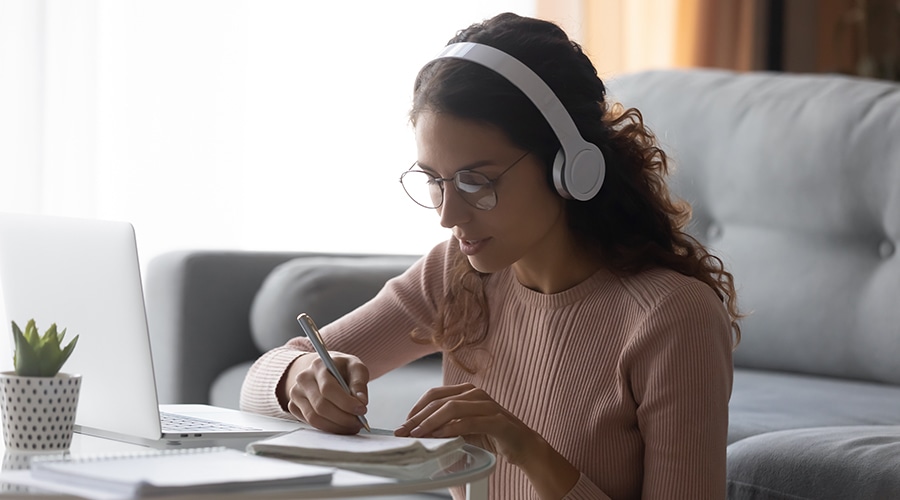- What's New
- Pricing & Purchasing
- Lead Times
- Literature & Samples
- Services & Warranties
- Careers
- Find a Rep
How Have Colleges Adjusted to Remote Learning?

When schools transitioned to distance learning this spring, we began conducting a series of interviews to understand how elementary, high school and college students navigated the experience.
Six months later, we’re checking back in with those students to see how they’ve adjusted and how remote learning has evolved.
This week, we interview two college students, a sophomore marketing major and a senior who will graduate with a degree in entrepreneurial management. Between the two of them, they're taking a variety of courses, including financial accounting, ethnic studies, business writing, biology and information systems and technology.
They'll share their thoughts on how their schools and professors adapted over the summer, how they and their peers are faring this fall and what they wish their schools had done differently. These conversations have been lightly edited for clarity.
KI: How is your school approaching this fall? Is it all distance-based learning or a mix of in-person and virtual learning?
Sophomore: All our classes are distance-based. One of my classes has four in-person discussions over the course of the semester.
Senior: It’s all distance-based. There’s a breakdown where some classes are pre-recorded, some are live over Zoom and one class is a mix of both.
KI: What do you like about distance-based learning this fall? Has what you like evolved from your experience in the spring?
Sophomore: I enjoy doing homework on my own time. I still have synchronous classes that I need to go to on a daily basis, but I can get homework done when I see fit.
In the spring, I felt more confined to a specific system. Now, I have more individual freedom. I can do my work at 11 p.m. instead of the specific times I did last year. My schedule really varies based on how I’m feeling that day.
Senior: I like the flexibility of being more in control of my time and budgeting it how I see fit. I also like the lack of the commute, especially as it gets colder.
Professors also have a better handle on virtual classes. Professors lay out the syllabus more coherently on our platform, Canvas. Most professors write assignments on a weekly basis. I like that it’s spread out because it would be overwhelming to see everything at once. You can concentrate your focus, so you’re not worrying about something five weeks away.
When classes were in person, I think professors relied on communicating in class. Now that they have less face time, they’re better about organizing.
KI: What do you wish were different about distance-based learning this fall? Why? Is that the same or different from your experience in the spring?
Sophomore: I’d like to see a return to in-person learning. I think a lot of students, myself included, learn better in class. We had more collaboration with peers, and now you don’t have that. Class is basically reading a textbook or watching YouTube videos; it’s not as interesting as in-person instruction.
Spring semester was a little strange because we went from in-person to online very quickly. It was frantic. This semester feels better because professors had time to structure their approach to teaching and learning.
Senior: Some professors overcompensate a bit in terms of the amount of work to be done. Taped lectures can be dry and repetitive. Even with live lectures, you’d hope there would be more engagement, but some professors still seemingly talk to no one. The lack of engagement is really tough for professors, but it does make it harder for me as a student to engage with them.
In the spring, professors had to do online learning on the fly. But people were more apt to have their cameras on and engage in class, whereas now we have more Zoom fatigue. People realize they can turn their camera off, go on mute and work on something else. It’s more difficult to stay motivated and engaged in lectures, especially when they’re not inherently interesting. For taped lectures, I’ll bump the video up to play at double speed to get through it as quickly as possible.
I wake up, move five feet to my desk and sit there for eight hours a day. It’s difficult to stay motivated in a lot of senses.
KI: Can you tell us about a project or assignment you had fun with? What did you like about it?
Sophomore: I’m passionate about writing and creating things because I like seeing the end result come together. I wrote a midterm essay for my ethnic studies class. It’s a general education class that you might otherwise slack off in, but it’s easy to pay attention because it’s really interesting.
Senior: In my marketing class, we had a group assignment where we had to find print magazine advertisements that we liked and didn’t like and explain why. People in my group were really organized. They knew what we were talking about and what we needed to do after meeting. Something I don’t like about group projects is when we get together for the sake of it, but don’t really need to be. I don’t like having my time wasted. This project felt more akin to how businesses operate -- you only meet when you have to.
KI: How is your experience using technology for distance learning? Do you like it? Have you had any technical difficulties?
Sophomore: The technology itself has been pretty decent. But participation has gone down. We do some breakout groups here and there, but people aren’t very engaged. It’s just not the same as being together in person. I get that you go to school to learn. But you also go to school to interact and network with people. Incorporating some collaboration would be a lot more enjoyable than just having to watch lectures online.
Some professors are sending assignments out on the learning platform without telling students. You’ll get a notification through the platform, but it doesn’t necessarily say that what came through was a new homework assignment. Now, I’m spending nine hours a day checking for these notifications because the communication isn’t there.
Senior: It’s been good. I like Zoom quite a bit, especially compared to Google Meetings and other tools that are less robust. Canvas has a pretty decent infrastructure as well.
It can be challenging when projects don’t lend themselves to virtual collaboration. I have one project where we’re doing financial statements in Excel. We’ll try to work on it together and there are too many cooks in the kitchen, with everyone working on the same cell.
KI: Do you like distance-based learning more than, less than or the same as you did in the spring? Why?
Sophomore: I like it a little more. Maybe it’s because I was at home this spring semester and wasn’t as motivated. Since I’m here on campus, I can live my life as normally as possible, and I’m more focused on my studies. But it’s different for everyone. It’s one of those things where no two people will have the same level of productivity in the same environment.
Senior: Less, just because it’s hard to stay motivated. In the spring, I would’ve said I liked it a little more because I liked the flexibility but hadn’t experienced the fatigue.
KI: Are you participating in any extracurricular activities or sports? Which ones?
Sophomore: I’m involved in the campus entrepreneurship organization on campus. We’ve had some meetings in person; a lot of them are virtual. You’d think that staying in touch through online meetings would be easy. But people haven’t really been motivated to do much this semester, which is understandable.
Senior: Not aside from going to the gym. I do freelance social media management for a handful of clients. A lot are on a pretty limited basis right now, but I’m looking to scale it up once I graduate. With the flexibility of school and working remotely, I can fit a lot more into my day than if we were in school in person. I can balance school and work more effectively.
KI: What do you miss most about going to school in person?
Sophomore: I miss seeing my friends on a daily basis. I like making friends in class who I can study with or who share my interest in marketing and entrepreneurship. I miss being able to sit in class without a trash bag covering the desk next to me. I miss being able to converse with people.
Senior: In-class engagement. I miss raising my hand and connecting in person with professors.
KI: Are you staying in touch with your friends? Has the way you communicate changed?
Sophomore: My roommate and I still go out and see our friends. Since we live in university housing, we get tested for COVID every two weeks. There are risks to going out, but I’m only in college for four years of my life. Am I going to spend seven months of that sitting in my dorm?
Senior: It’s been easier since we’ve been back on campus. We keep a pretty tight circle, so we’ve been able to hang out and have it feel pretty normal. Our weekend activities have changed quite a bit. We don’t go to proper parties anymore. We’re not seeing a lot of new faces. I basically interface with the same eight people, which can get kind of redundant.
KI: When schools return to in-person learning, would you want to continue some amount of distance learning?
Sophomore: I wouldn’t mind. Some classes are better online. You can work a week ahead in some classes and then focus on two classes in one week. But I think all the classes that are pertinent to your major should be in person.
Senior: Definitely. If my biology class was offered in that modality, I’d be more inclined to take it than if I had to be there in person. It’s a good fit for distance learning because I think I would’ve sat in class and thought the subject matter was interesting, but I don’t think I would’ve had a lot to add. This way, I can take the class at my own pace.
KI: Is there anything else you’d like to add about this whole experience?
Senior: The biggest thing is that it’s hard to stay motivated. If you don’t have time management skills, it shows up. You can push lectures off to watch them whenever. It’s helpful to have set blocks in my day to schedule around. Now I plan every part of my day pretty granularly.
Flexibility and Fatigue
Clearly, there are some upsides to remote learning, like flexibility and the freedom to manage one’s own time. But if the thoughts of our two college students are any indication, the future of distance learning is one of moderation.
Stay tuned for the next student interview in our series on distance learning. Through these conversations, we’ll learn how to make the most of in-person and remote learning alike.
Subscribe
Stay up to date with the latest trends and more.
